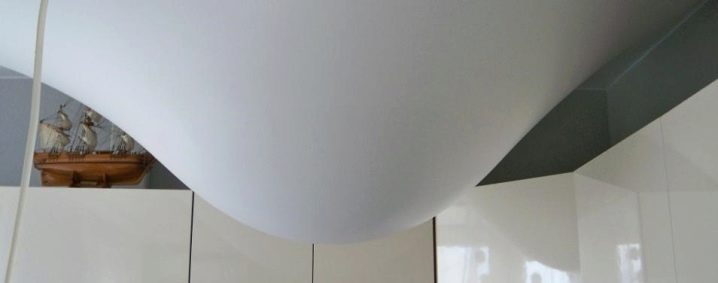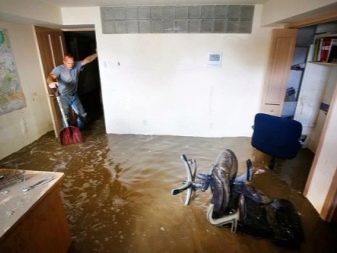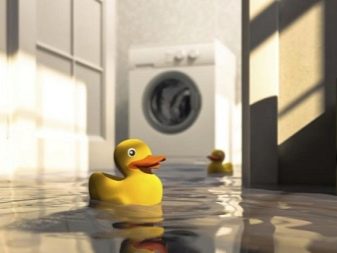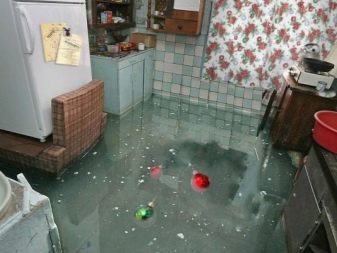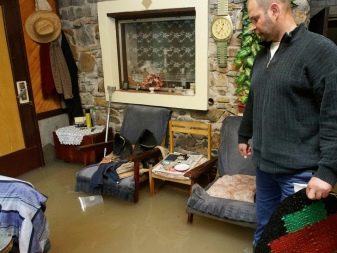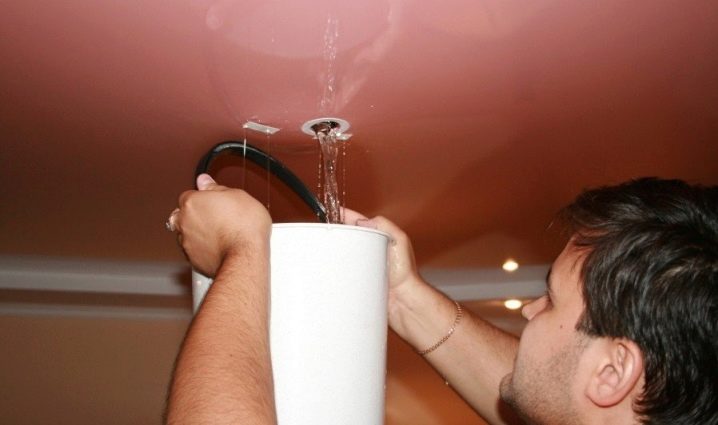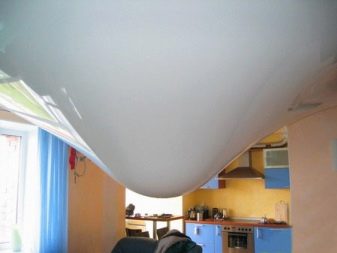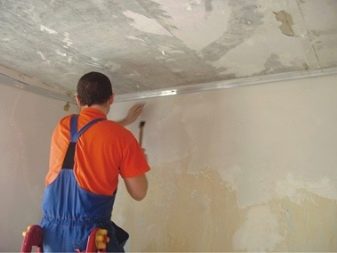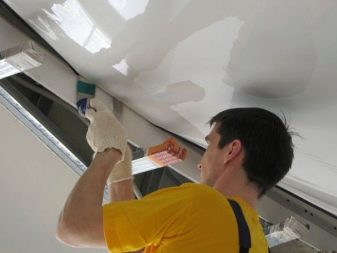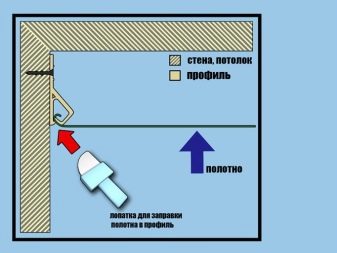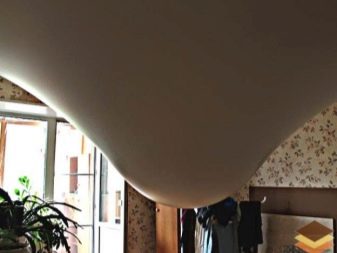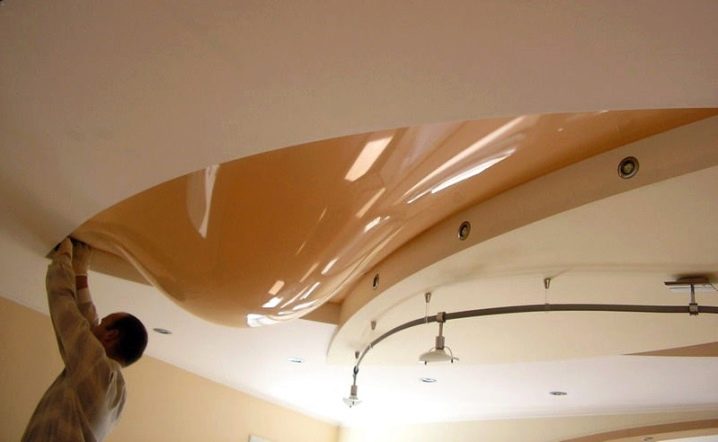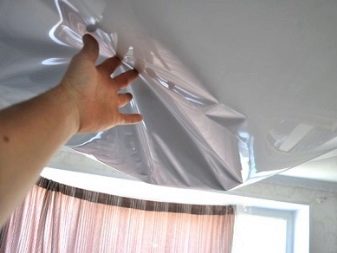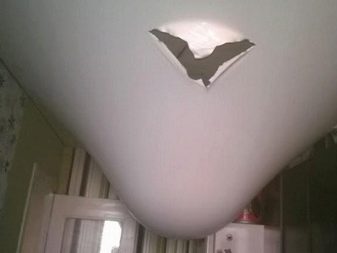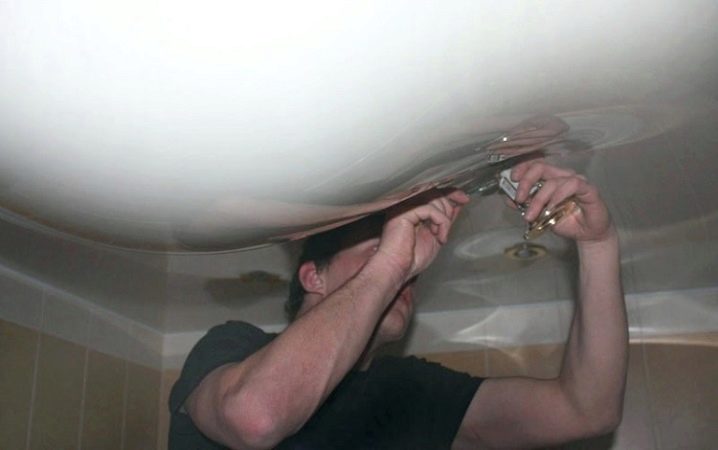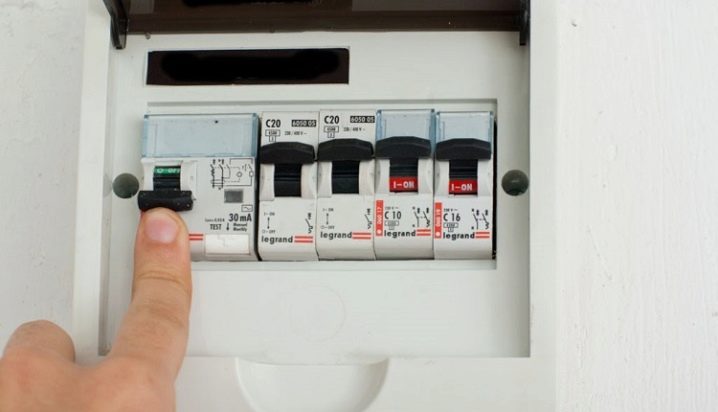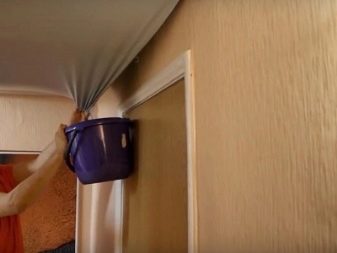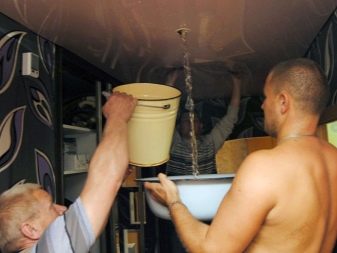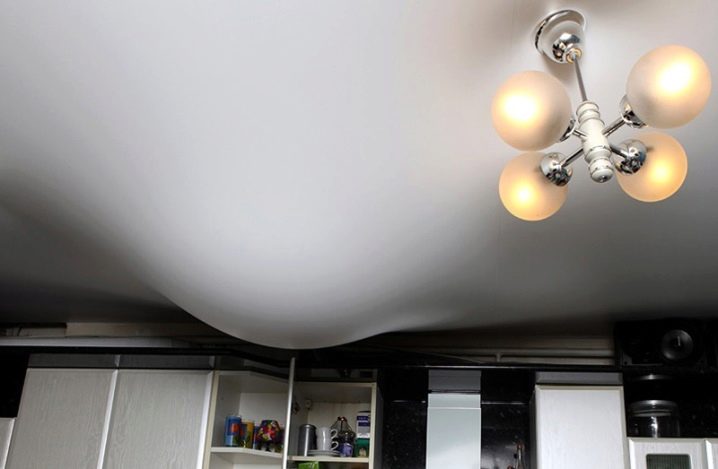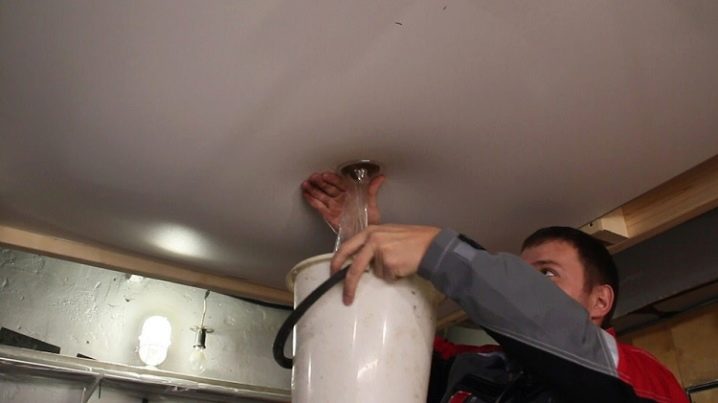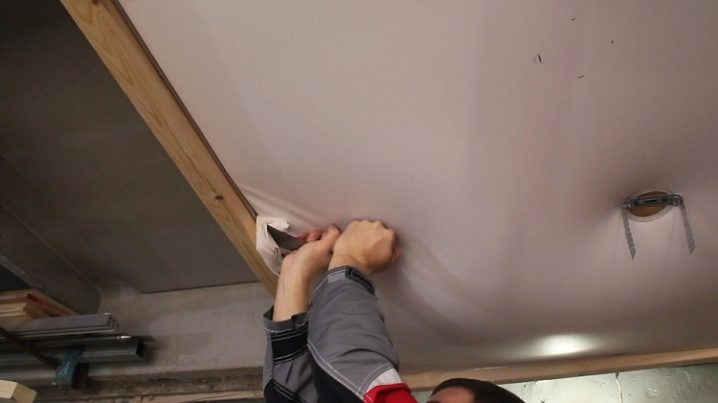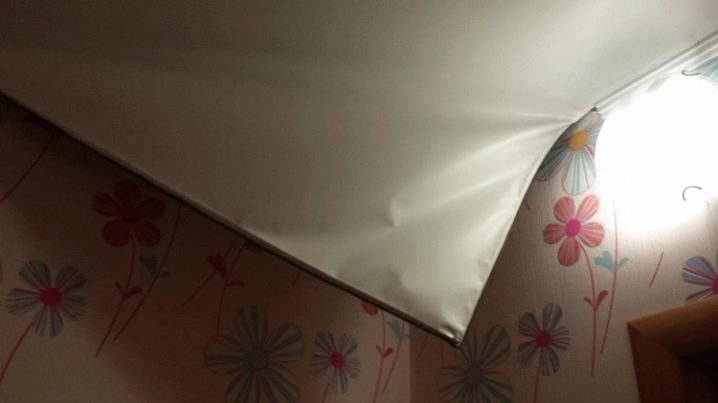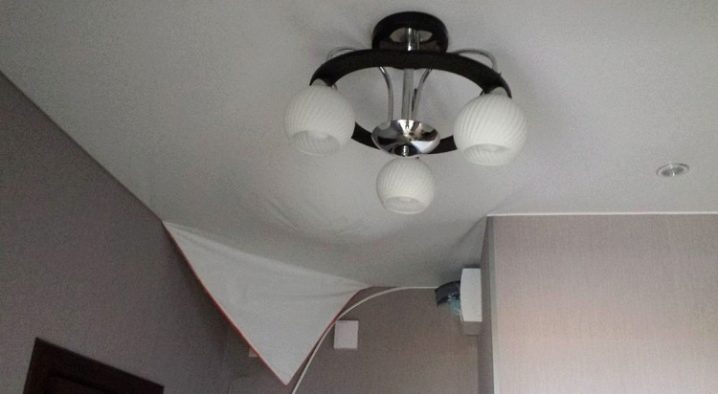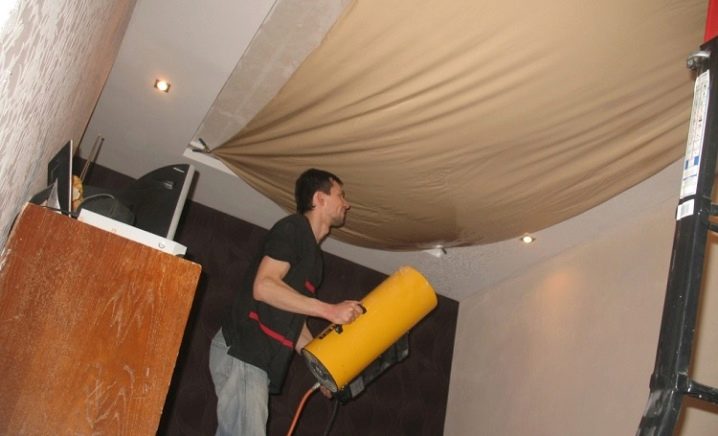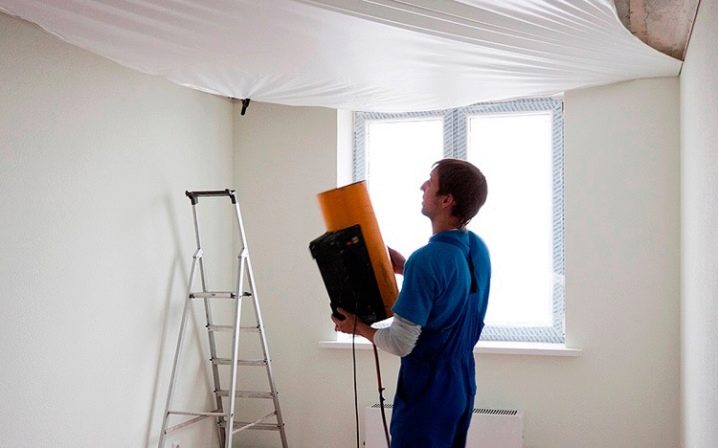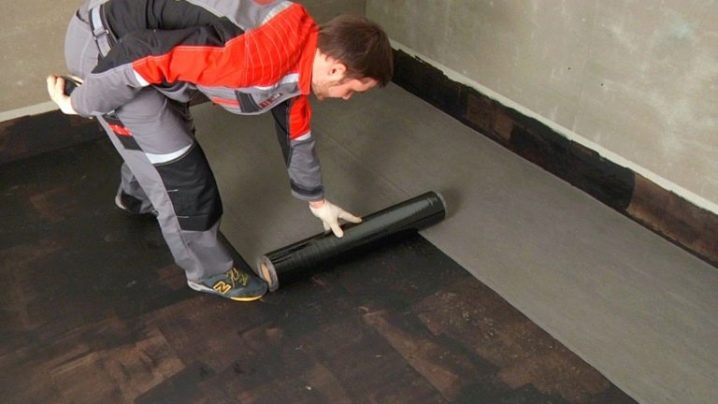Draining water from a stretch ceiling: detailed instructions
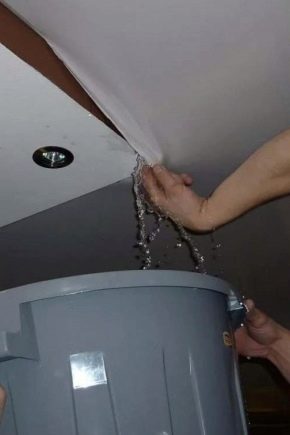
If the neighbors flooded you, then you need to know how to drain the water from the cloth that has accumulated there. Such a nuisance can happen around the clock, and it is necessary to pump out water quickly. Also, water in the stretch ceiling can accumulate for other reasons.
Causes of moisture
The overall impression of the interior depends on how the ceiling looks. The ceiling coating improves the room and gives the room a cozy look.
In life there are different circumstances, unforeseen situations. There are a number of factors that cause the appearance of water in the ceiling design.
These include:
- failure of the washing machine;
- defects in the storm sewer system;
- problems in the sewer system;
- rupture of pipes of the heating system;
- leaks in pipes with cold water;
- leaks in hot water pipes.
If your neighbors did not close the tap with water or it was blown off, or even a pipe burst, the ceiling will be flooded with clean water. But here its temperature is very important. Cold or barely warm water will not cause significant damage to the stretch ceiling, unlike hot water, which, once on the film, can deform and completely spoil it.
The situation with the breakthrough of the sewer system or its clogging - even more sad case, since the ceiling will also become dirty.
In order to avoid mold spots in the future, the ceiling definitely needs to be cleaned after you drain the water.
The highest floor is the potential risk of flooding due to rainwater obstruction. As a result, street water will fall on your ceiling. After the repair work, you will need to dry and wash the film.
In the event of a failure of a washing machine or dishwasher from the residents above, your ceiling will be filled with soapy water. Its volume may be minimal, but it will definitely not be clean.Subsequently, you also need to wash cloth. The worst option would be flooding with hot liquid.
In such a situation, urgent removal of water is required, until she managed to spoil the ceiling covering.
Flooding due to the breakthrough of heating pipes is also a big problem. Water not only can be hot, but will also differ in technical characteristics from tap water, therefore it will greatly affect the surface of the ceiling.
Flooding of the ceiling can occur in a single-story room. For example, if the roof requires repair and there are gaps in it, through which water can seep into the cavity of the tension film.
What weight can withstand the canvas?
The framework on which the suspended ceiling rests is a very important element of the strength index. Professionals advise to use an aluminum profile for installation. It is lightweight, reliable, withstands long-term operational load.
Another advantage is that if you want to change the color of the ceiling, you will need to buy only a new film, and the frame will remain unchanged.
The choice of fasteners is also an important element that affects strength. It is necessary to use hardware of proven manufacturers that guarantee the quality of products. Under each type of surface a certain type of polypropylene dowels and screws is selected.
Decorative edge on the entire surface of the ceiling is not only decoration, but also sealing joints. Her choice should be approached carefully. It will protect the junction and prevent water from leaking out.
If you comply with all the conditions of installation and selection of ceiling elements, then it will be able to sustain the weight of about 100 liters of fluid per square meter.
If the water no longer arrives, then it can remain there for almost an unlimited amount of time. But you should not risk it in vain. Water that has been in a confined space for a long time can lead to the multiplication of mold spores.
The stretched surface of the ceiling in case of accidental contact with a sharp object or the edge of the chandelier may simply burst. There is a risk of film divergence if the water column presses on the joint.
The flood must be eliminated within a few days. This is the optimal time for repair.
Errors
If it is decided to liquidate the bay independently, without the involvement of specialists, then common mistakes should be avoided:
- The most common mistake is incorrect determination of the amount of fluid in the suspended structure. It should correctly calculate how much improvised it will be needed to accommodate the draining water. If the volume of water is too large, it may be necessary to dry not only the films, but also the concrete base. It is recommended to treat all areas with antiseptic compounds.
- Independence. It is very difficult for one person to do all the manipulations, since you will not have the opportunity to move away from the design.
- Punctures canvases. Under the pressure of the volume, even the smallest hole will spread and everything around will be flooded with water.
- Moving water on the ceiling to the place of discharge you will not help, and further aggravate the situation. Because water will spill over the entire surface of the ceiling.
- To smooth the ceiling experts independently prohibit. It hurts him and deforms him. A household hair dryer does not help you to dry the ceiling and restore the coating. This is a hopeless occupation. Such work can be done only with the help of a professional heat gun.
- If you know that boiling water in the ceiling, do not forget about thermal gloves.
In order not to face the complete replacement of PVC film, it is better to entrust this business to professionals. Stretch ceilings do not miss the water and this advantage will give you time to call a brigade of repairmen.
Correct procedure
In the event of a ceiling flooding, the main recommendation is to set aside panic. Invited experts will cope with any problem. It is much better than trying to do everything yourself. Due to non-professional actions, the situation can only worsen.
The main actions that you can perform while waiting for the repair team:
- First, visit the neighbors and find out what happened to them. Then you can provide the necessary information to a specialist in repairing the type of water in your ceiling.
- To ask the residents from above if there is more water flowing, whether all the taps are blocked. Going to them and offering your help is still in your interest.
- Eliminating the source of flooding, blocking the general water stand, you can do furniture and valuable things that are in the room. Even if you have a huge sagging bubble of water, from your point of view, absolutely safe, do not be lazy.Take out things and furniture from the room, as in the process of draining water a small leakage may occur. Large furniture can be protected with a film.
- Turn off the electricity.
Consider some points in more detail:
- Before you begin to eliminate the flood, you should take care of their safety and de-energize the electricity. To do this, unscrew the plugs or simply turn off the machines on the electrical panel near your apartment. Fluid that seeps through the walls can get to the electrical wiring to the lighting fixtures. This may cause a short circuit.
- If suddenly the smell of burning rubber appears in the air, you need to call an electrician immediately. Possible ignition wiring.
- Since electricity and water are almost incompatible things, security needs to be taken seriously. If you drain the water from the ceiling, you can still try to do it yourself, then the repair of electrical wiring is just beyond normal human capabilities. Here only professionals of the business will deal with the current situation.
How to drain without damage?
The choice of the method of removing the liquid depends on the location of the slack and on the design features of the ceiling. There are two options:
- Water descending through lighting devices, if there is a special opening near the place of sagging;
- Descent through the edge of the canvas by detaching from the fastening elements. It can be used if there are no special openings near the slack.
Consider in detail the procedure for draining water.
How to pump out the liquid, using the hole for lighting devices:
- disconnect appliances from electricity;
- bring water tanks, the more the better;
- dismantle the lamp;
- very gently move the canvas down and hold until it drains the entire volume of water;
- the canvas must be pulled down until the water flow stops;
- if the bubble is too large, you need the help of a second master who will lift it up until the water flows down.
It is necessary to focus on several points:
- In the stretch canvas, the contours of the holes are additionally reinforced with a special ring. When the canvas is pulled down, you need to deftly fix this element with your fingers, pushing them into the hole.If you grab the ring incorrectly, there is always the risk of damaging it.
- When the last drop of water falls into the tank, the repair can be considered successful. But do not hurry with the installation of lamps. Not earlier than in a week it is recommended to put them back and turn on the electricity again. It is necessary to eliminate the risk of closure, so speed is not the main thing in this matter.
The procedure for draining the water with the dismantling of the edge:
- find out to which segment of the perimeter the bubble hangs closest;
- pull the canvas out of the profile;
- Drain the fluid by moving the bubble toward the edge.
How to detach the film from the profile in the case of a wedge construction:
- remove the bead;
- pry triangle wedge;
- pull it to the desired distance;
- release the film.
In the case when the film is snapped to the ceiling profile, it plays the role of a clothespin into which the canvas is inserted with the help of tools. To detach the edge of the film, you need to click on it at the very profile. Independently right edge of the canvas will not succeed. This question is solved by the master with professional equipment.
The harpoon ceiling is the most common type of stretch ceilings. For its dismantling need a spatula.If it is not at hand, you can try to do it with a regular plastic card.
Cloth drying and processing
After all the work done, it is unlikely to be able to return the original look to the ceiling immediately. The film at the place of sagging will go rippling.
To align the coating, you need to have a professional heat gun. It warms the air in the room to + 50 ° С. After cooling, the coating will be perfectly flat and smooth.
The process of drying the ceiling is not the fastest. Humidity can cause mold. Therefore, the flow area and the concrete base must be antiseptic before being returned to the site. It is best to use aerosols.
The process of restoring the ceiling should be carried out using a heat gun or a building dryer. Depending on the type of ceiling, the installation of the dried film takes place. Final drying may take a week.
This time is needed to evaporate all moisture and short circuit does not occur.
Flood prevention
To avoid flooding the ceiling, it’s best to have the tenants on top of them waterproof the floor,that is, put a layer of roofing material on the screed or made a coating layer with bitumen mastic. Then the water will not flow down. This method requires an investment of money and time. Not every neighbor will agree to this. After all, you have to dismantle the old coating, lay a waterproofing layer and then return the topcoat (tile, linoleum). This method is not effective if the water flows through the floors between the floors. No one would do such a comprehensive repair just like that. But if there is a repair over you, it makes sense to talk about it with the tenants.
Remove the water and return the appearance of the ceiling cover is easy, if you strictly follow the advice of professionals in this field.
For more information on this issue, you can find out by watching the video below.
